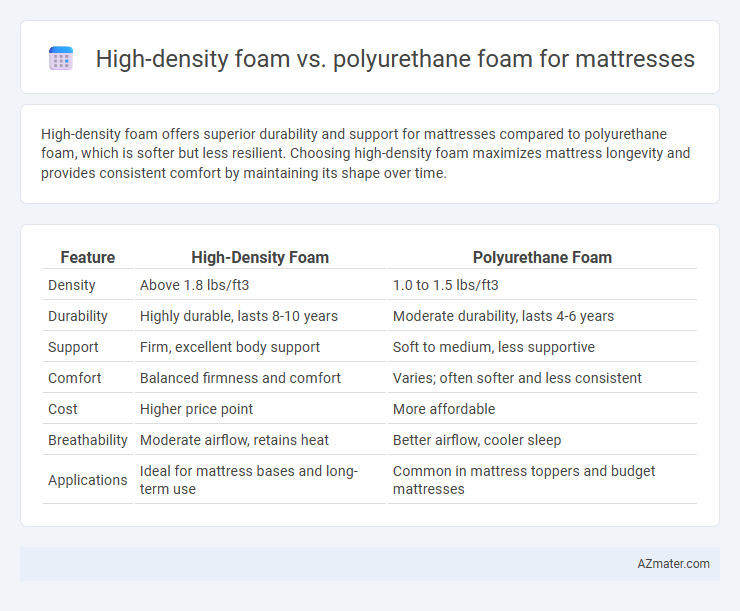High-density foam offers superior durability and support for mattresses compared to polyurethane foam, which is softer but less resilient. Choosing high-density foam maximizes mattress longevity and provides consistent comfort by maintaining its shape over time.
Table of Comparison
| Feature | High-Density Foam | Polyurethane Foam |
|---|---|---|
| Density | Above 1.8 lbs/ft3 | 1.0 to 1.5 lbs/ft3 |
| Durability | Highly durable, lasts 8-10 years | Moderate durability, lasts 4-6 years |
| Support | Firm, excellent body support | Soft to medium, less supportive |
| Comfort | Balanced firmness and comfort | Varies; often softer and less consistent |
| Cost | Higher price point | More affordable |
| Breathability | Moderate airflow, retains heat | Better airflow, cooler sleep |
| Applications | Ideal for mattress bases and long-term use | Common in mattress toppers and budget mattresses |
Understanding High-Density Foam and Polyurethane Foam
High-density foam features a higher weight per cubic foot, typically above 1.8 pounds, offering enhanced durability and superior support for mattress applications. Polyurethane foam, commonly used in mattresses, varies in density from low to high, with lower-density foams providing softer comfort but less resilience, and higher-density foams improving longevity and firmness. Understanding the density and composition of these foams is essential for selecting a mattress that balances pressure relief, motion isolation, and overall comfort.
Key Differences Between High-Density and Polyurethane Foam
High-density foam offers greater durability and support due to its higher weight per cubic foot, making it ideal for long-term mattress use and pressure relief. Polyurethane foam, often lighter and less expensive, provides basic cushioning but tends to compress faster and wear out sooner. The key differences lie in density, lifespan, and comfort level, with high-density foam excelling in resilience and support compared to the more affordable but less durable polyurethane foam.
Comfort and Support: Which Foam Performs Better?
High-density foam offers superior support and durability for mattresses, maintaining shape and providing consistent comfort over time. Polyurethane foam is softer and less dense, making it less effective in providing long-term support but often more affordable and initially plush. For optimal balance of comfort and support, high-density foam generally outperforms polyurethane foam, especially for those needing pressure relief and spinal alignment.
Durability and Longevity: What to Expect
High-density foam mattresses offer superior durability due to their closely packed cells, providing longer-lasting support and resistance to sagging compared to polyurethane foam, which tends to break down faster under consistent use. Polyurethane foam mattresses usually have a shorter lifespan, often softening or developing indentations within a few years, whereas high-density foam can maintain structural integrity for 8-10 years or more. Consumers seeking long-term investment in mattress resilience typically prefer high-density foam for its ability to retain firmness and comfort over extended periods.
Cost Comparison: High-Density Foam vs Polyurethane Foam
High-density foam mattresses typically cost more than polyurethane foam mattresses due to their superior durability and support qualities. Polyurethane foam is less expensive but may compress faster, reducing its lifespan and value over time. Comparing prices, high-density foam ranges from $100 to $300 per mattress, while polyurethane foam options often start as low as $50, making the latter more budget-friendly upfront but potentially less cost-effective long-term.
Breathability and Temperature Regulation
High-density foam offers superior support but tends to retain heat due to its compact cell structure, leading to reduced breathability and less effective temperature regulation. Polyurethane foam varies in density and often contains open-cell structures that allow better airflow, enhancing breathability and promoting cooler sleep conditions. For optimal mattress comfort, selecting polyurethane foam with open-cell technology provides improved ventilation and temperature control compared to conventional high-density foam.
Motion Isolation and Noise Reduction
High-density foam offers superior motion isolation by efficiently absorbing and minimizing movement transfer, making it ideal for couples sharing a mattress. Polyurethane foam typically provides less effective motion isolation due to its lower density and resilience. Noise reduction is more pronounced in high-density foam mattresses, as their dense structure minimizes creaking and other sounds compared to the often noisier polyurethane foam constructions.
Health and Safety Considerations
High-density foam mattresses offer superior durability and support while typically emitting lower levels of volatile organic compounds (VOCs), reducing potential respiratory irritants compared to standard polyurethane foam. Polyurethane foam often contains flame retardants and chemicals that can off-gas harmful toxins, impacting indoor air quality and posing health risks, especially for individuals with asthma or allergies. Choosing CertiPUR-US certified high-density foam ensures compliance with strict health and safety standards, promoting a safer sleeping environment.
Choosing the Ideal Foam for Your Sleep Needs
High-density foam offers superior durability and support, making it ideal for individuals who require consistent pressure relief and spinal alignment. Polyurethane foam provides a softer, more affordable option with varied density levels suited for light sleepers or budget-conscious buyers. Selecting the ideal foam depends on personal sleep preferences, body weight, and the desired balance between comfort and longevity.
Final Verdict: Which Foam Is Best for Mattresses?
High-density foam offers superior durability, support, and pressure relief compared to standard polyurethane foam, making it ideal for long-lasting mattress comfort. Polyurethane foam typically provides a softer, more affordable option but tends to degrade faster and lacks the consistent support of high-density foam. For mattresses prioritizing longevity, spinal alignment, and overall comfort, high-density foam emerges as the best choice.

Infographic: High-density foam vs Polyurethane foam for Mattress
 azmater.com
azmater.com